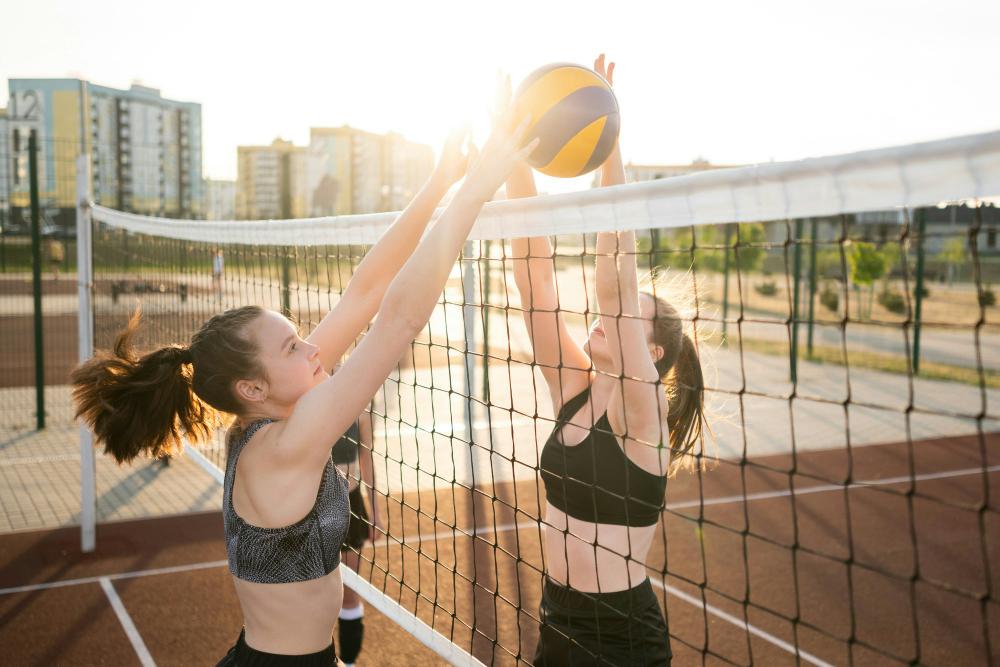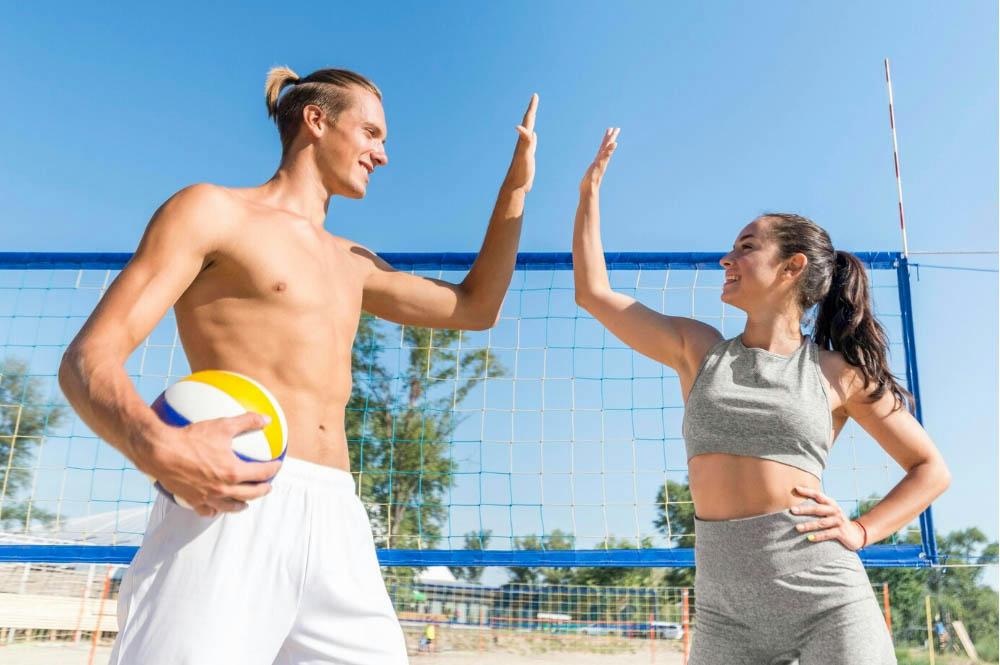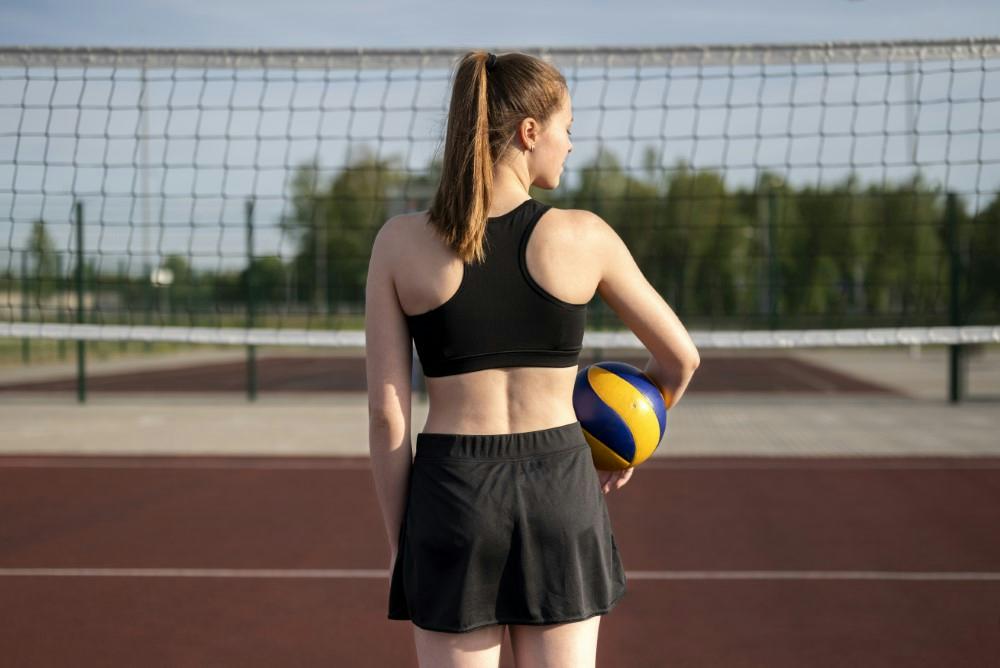Introduction
Volleyball, a dynamic and exhilarating sport, demands agility and strength from its players. However, the repetitive nature of certain movements can lead to volleyball shoulder pain, a common condition among enthusiasts.
In this article, we delve into the intricacies of preventing shoulder pain in volleyball, ensuring players can enjoy the game without the discomfort.
Understanding Shoulder Pain in Volleyball
Before we jump into prevention strategies, let’s take a moment to understand the shoulder’s anatomy.
The shoulder is a complex joint susceptible to various injuries in volleyball players. Whether it’s spiking, serving, or diving for a ball, the shoulder undergoes tremendous stress. This stress makes players susceptible to sore shoulders from volleyball and increases the likelihood of experiencing pain and discomfort, particularly when the joint is pushed to its extreme position during intense gameplay.
According to a study, the stress exerted on the arm during overhead strikes causes a significant prevalence of shoulder problems. Up to 23%-43% of competitive volleyball players report shoulder discomfort throughout a season. Another study found that attackers and “jump” servers were more likely to have shoulder issues than setters, defensive specialists, and “float” servers.
Bodybuilder claims plants helped to improve his psoriasis clenbuterol gyl naked female bodybuilder angela salvagno’s big clit
Symptoms of Shoulder Pain in Volleyball

Volleyball shoulder pain can be a formidable adversary, silently creeping in and affecting players’ performance. As a proactive step towards effective intervention and injury prevention, recognizing the symptoms early on is crucial.
Persistent Aches
One of the primary indicators of potential shoulder issues is the presence of persistent aches. Players should be attentive to any lingering discomfort in the shoulder region, especially after intense practice sessions or matches. A persistent ache that doesn’t subside with rest could signify an underlying problem that needs attention.
Limited Range of Motion
Shoulder pain often manifests as a restriction in the range of motion. Players may notice difficulty raising their arms overhead, executing certain volleyball techniques, or even during routine activities. If reaching or lifting becomes challenging due to discomfort, it’s a clear signal that the shoulder demands attention.
Discomfort During Play
A telltale sign of shoulder pain is the discomfort experienced during play. Players may notice a twinge or ache when executing specific moves like spiking, serving, or even basic overhead passes. Ignoring this discomfort during gameplay can exacerbate the issue, leading to more severe injuries.
In a survey involving 2,352 volleyball players, nearly half (46%) revealed that they experienced interference in their ability to play due to shoulder pain. Moreover, out of the 30 surveyed volleyball attackers with shoulder pain, a significant 77% reported that the pain affected their precision in placing attack shots on the court.
Why Early Identification Matters
Early identification of these symptoms is paramount for several reasons:
Prevention of Escalation
Recognizing shoulder pain in its early stages allows players to address it before it escalates into a more severe injury. Timely intervention can prevent prolonged downtime and ensure a faster recovery.
Preservation of Performance
Shoulder pain, if left untreated, can significantly impact a player’s performance. By identifying symptoms early, athletes can maintain their level of play and avoid declining skill and agility.
Avoidance of Chronic Conditions
Persistent shoulder pain, if disregarded, may lead to chronic conditions that can jeopardize a player’s long-term participation in the sport. Early intervention helps mitigate the risk of chronic shoulder problems.
What Causes Shoulder Pain in Volleyball?

The causes of shoulder pain in volleyball are multifaceted. Repetitive overhead motions, such as spiking and serving, contribute to overuse injuries. Poor technique, lack of conditioning, and inadequate rest can also exacerbate the problem. Understanding these factors is the first step toward effective prevention.
Common Volleyball Shoulder Injuries
Rotator Cuff Tendonitis
Description: Inflammation of the tendons that stabilize the shoulder joint.
Impact on Players: This condition results from overuse or repetitive motions, which is common in volleyball. Players may experience pain, weakness, and limited range of motion.
Shoulder Impingement Syndrome
Description: Compression of the rotator cuff tendons between the humerus and shoulder blade.
Impact on Players: Shoulder impingement can cause pain and reduced shoulder mobility, especially during overhead movements like serving and spiking.
Labral Tears
Description: Tears in the cartilage lining the shoulder socket.
Impact on Players: Labral tears can result from sudden trauma or overuse. Players may experience pain, instability, and a popping sensation in the shoulder.
Bursitis
Description: Inflammation of the fluid-filled sacs that cushion the shoulder joint.
Impact on Players: Bursitis leads to pain, swelling, and tenderness in the affected area. Overhead movements in volleyball can exacerbate this condition, affecting the soft tissue surrounding the shoulder joint’s cushioning sacs.
Treatment for Shoulder Pain
If shoulder pain strikes, immediate action is key:
Rest: Take a break from volleyball to allow your shoulder to heal.
Ice: Apply ice packs to the area for 15-20 minutes daily to reduce inflammation.
Pain medication: Over-the-counter pain relievers like ibuprofen can help manage pain.
Physical therapy: A physical therapist can design a rehabilitation program to strengthen your shoulder, improve flexibility, and correct any underlying biomechanical issues.
How to Prevent Shoulder Pain?
Preventing shoulder pain requires a comprehensive approach. Let’s explore three key pillars of prevention that every volleyball player should incorporate into their routine to mitigate the risk of future injuries.
Prevention through Proper Technique
The cornerstone of preventing shoulder pain is mastering and consistently employing proper techniques. Whether executing a powerful spike or delivering a precise serve, maintaining correct posture and alignment is paramount. Athletic trainers and players alike should place a premium on refining and reinforcing these techniques during training sessions. In this context, enlisting the aid of a ghostwriter für online klausur can be a strategic approach for athletes who must balance academic demands with rigorous training schedules. As a partner in academic support, this service allows athletes to maintain their academic integrity while dedicating necessary time to their physical preparation.
Tips for Proper Technique
Posture Matters:
Ensure that players maintain a neutral spine and balanced posture during various volleyball movements. This reduces the strain on the shoulders and enhances overall performance.
Alignment is Key:
Emphasize the importance of proper shoulder joint alignment during actions like spiking, serving, and passing. Misalignment can lead to unnecessary stress and increase the risk of common injury.
Consistent Training:
Regular and consistent training drills focusing on technique allow players to engrain proper movements into muscle memory. This consistency translates to better execution during actual gameplay.
Prevention through Physical Conditioning
Conditioning the shoulder muscles is a proactive measure to fortify the body against potential injuries. Incorporating targeted corrective exercises into the training regimen enhances both strength and shoulder stability, providing a solid foundation for the musculoskeletal system.
Effective Conditioning Strategies
Strength Training:
Integrate shoulder-specific strength exercises, utilizing equipment such as a resistance band. Include shoulder presses, lateral raises, and rotator cuff muscle exercises. Strengthening these muscles adds a protective layer, reducing vulnerability to strains.
Flexibility Exercises:
Include dynamic and static stretches to improve shoulder flexibility. This helps maintain a full range of motion and minimizes the risk of common volleyball injuries during sudden and dynamic movements.
Balanced Workouts:
A holistic approach involves addressing both strength and flexibility. Volleyball shoulder workouts ensure that no muscle group is overdeveloped, promoting overall shoulder health.
Prevention through Rest and Recovery
In the quest for excellence, the significance of rest often gets overlooked. Adequate rest is essential for allowing the shoulder muscles to recover from the strain of intense gameplay. Players should conscientiously integrate rest days into their schedule, complemented by proper recovery techniques like stretching and massage.
Optimizing Rest and Recovery
Scheduled Rest Days:
Establish a training schedule that incorporates dedicated rest days. These intervals provide the muscles with the necessary time to recuperate and regenerate.
Active Recovery:
Encourage low-intensity activities on rest days, such as light jogging or swimming, to promote blood flow without imposing excessive stress on the shoulders.
Professional Assistance:
Consider consulting with a healthcare professional or physical therapist to incorporate targeted recovery techniques. Massage helps alleviate muscle tension, promoting quicker recovery.
When to Seek Physical Therapy?

Despite preventive efforts, volleyball injuries may still occur. Recognizing when to seek physical therapy is pivotal. Persistent or worsening pain, decreased range of motion, and difficulty in performing routine activities are indicators that warrant professional intervention. Early rehabilitation can prevent chronic issues and expedite recovery.
If you’re suffering from persistent pain, consider seeking physical therapy in Goshen, Indiana, for comprehensive assessment and targeted treatment. Experienced physical therapists can help identify the root cause of your discomfort, design personalized rehabilitation plans, and guide you through exercises to restore strength and flexibility.
Conclusion
In conclusion, preventing shoulder pain in volleyball is a holistic endeavor. From understanding the nuances of shoulder anatomy to embracing proactive measures like proper technique, conditioning, and rest, players can safeguard against injuries. By prioritizing shoulder health, athletes ensure longevity in the game they love.
FAQs
How do I stop my shoulders from hurting in volleyball?
Consistently practice proper technique, engage in shoulder exercises, and prioritize adequate rest between intense sessions.
How do you strengthen your shoulders for volleyball?
Include targeted volleyball shoulder workouts in your training routine, focusing on strength and flexibility to build resilient shoulder muscles.
Why does my shoulder hurt when I overhand serve in volleyball?
Overhand serving involves repetitive shoulder motions, and improper technique or muscle imbalances can contribute to pain. Correct form and strengthening shoulder exercises can mitigate this discomfort.


